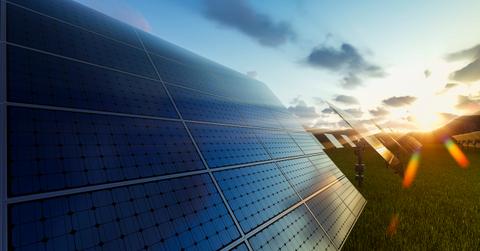Minnesota Leads Country In Community Solar Energy
In a community solar energy system, people can opt to share solar energy from one network, splitting costs. This system has taken off in a big way in Minnesota, which now leads the U.S. in successful community solar programs.
Updated May 17 2019, 12:20 p.m. ET
Minnesota is known for its natural beauty and iconic local accent, but not so much for abundant sunlight. In fact, Minnesota tends to be generally overcast, so it makes sense that most people don't immediately think of Minnesota in relation to solar energy. But the fact is, though Minnesota doesn't produce nearly as many total watts of solar power as sunnier states like Arizona or California, it does lead the U.S. in one particular kind of solar power: community solar.
According to Energy Sage, the term "community solar" describes any solar energy program in which a group of residents can opt to share solar energy from one network, splitting clean energy costs among themselves. Such programs, if efficiently run, have the potential to save consumers a substantial amount in energy costs over time.
The popularity of such programs has soared in Minnesota since 2013, when the Solar Energy Jobs Act was signed into law. Among other changes to Minnesota's energy policies, the Solar Energy Jobs Act made it possible for community solar to operate with no cap. It was this simple change that secured Minnesota's lead in successful community solar programs in the United States.
Toward the end of 2016, only about 120 total megawatts existed in community solar projects across the U.S., according to Ozy. Now, in Minnesota, 478 community solar projects are getting ready to launch, which will lead to a total of around 1,000 megawatts being produced. Many of these new projects have been introduced by state utility Xcel, including two of the largest in the state: the North Star and Aurora Solar projects.
Combined, Minnesota's community solar programs ultimately helped to increase the state's solar energy output 12 times over from 2015 to 2016--a monumental increase unlike anything seen in other states.
If there is anything to learn from the monumental solar energy boom Minnesota has experienced since 2013, it may well be that community-based clean energy has the potential to be popular. This is especially true when states do all they can to make such projects affordable for average consumers, as Minnesota has striven to do.
The state is working on a "valued solar rate," to make solar energy more accessible, a far cry from states where residents must pay a premium to access clean energy. The idea that average residents should be able to access clean energy seems to be at the heart of the changes rapidly taking place in Minnesota.
Recently, St. Paul, Minneapolis and 29 other Minnesota localities pledged together to purchase 33 megawatts of solar subscriptions. Even government groups and schools are jumping on board, purchasing 25-year energy contracts in order to save money on long term energy costs. Sara Bergan, an energy law attorney for Pacific Northwest firm Stoel Rives, told Ozy that the principle behind community solar programs is that "in theory, it expands access to solar development to everybody." It's a simple concept, but one that has fueled great success and change in Minnesota, thus far, with no signs of slowing down.
